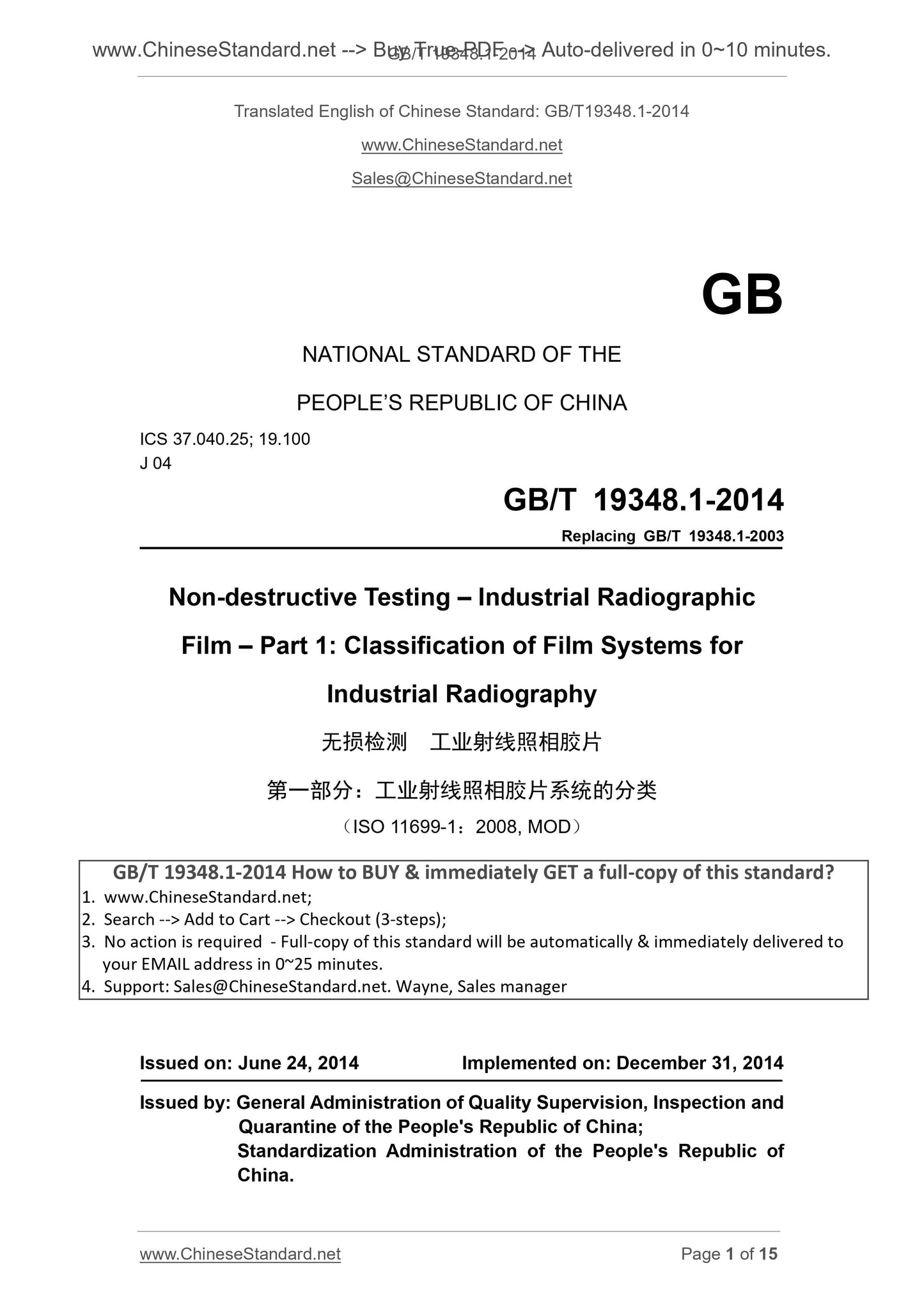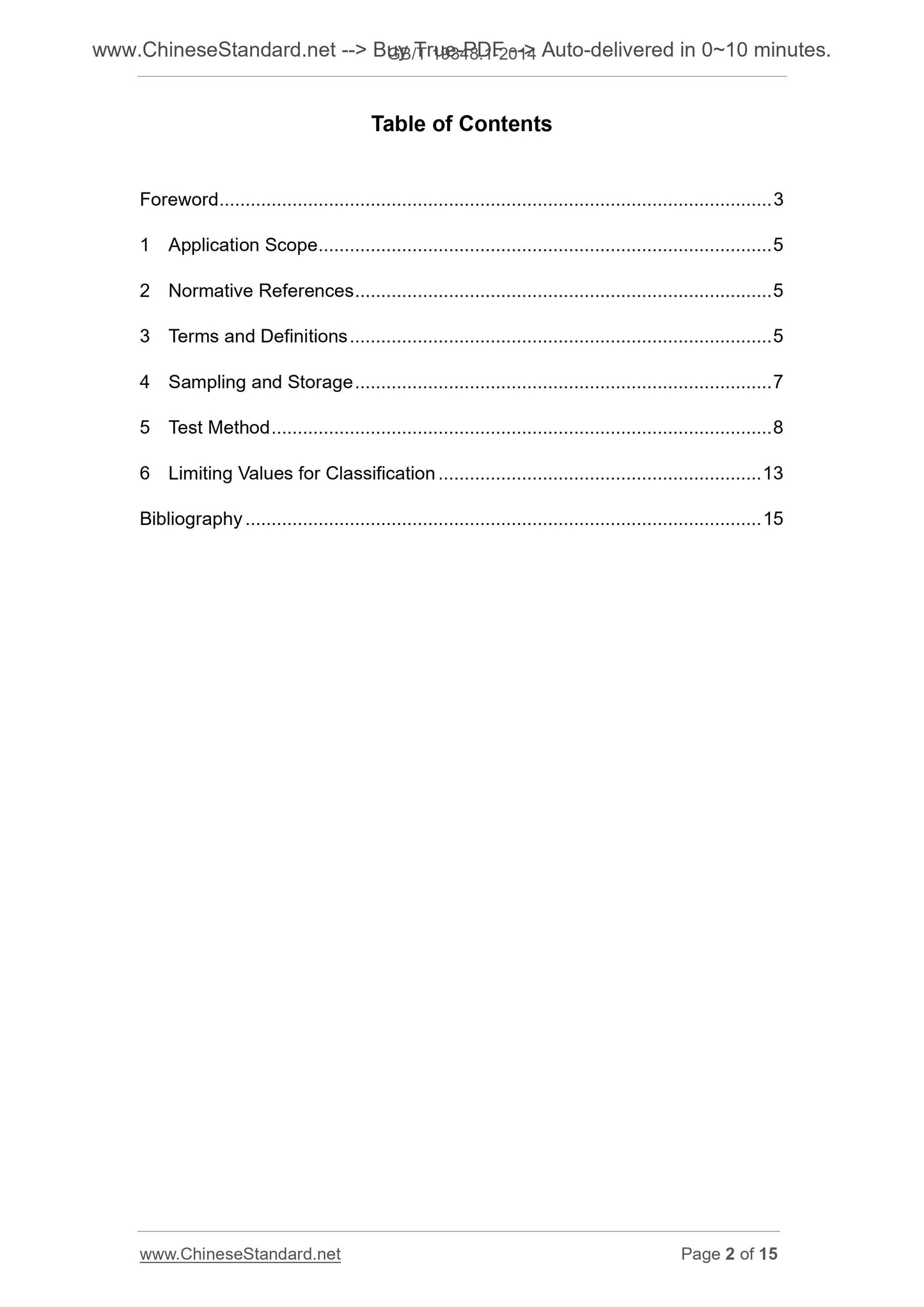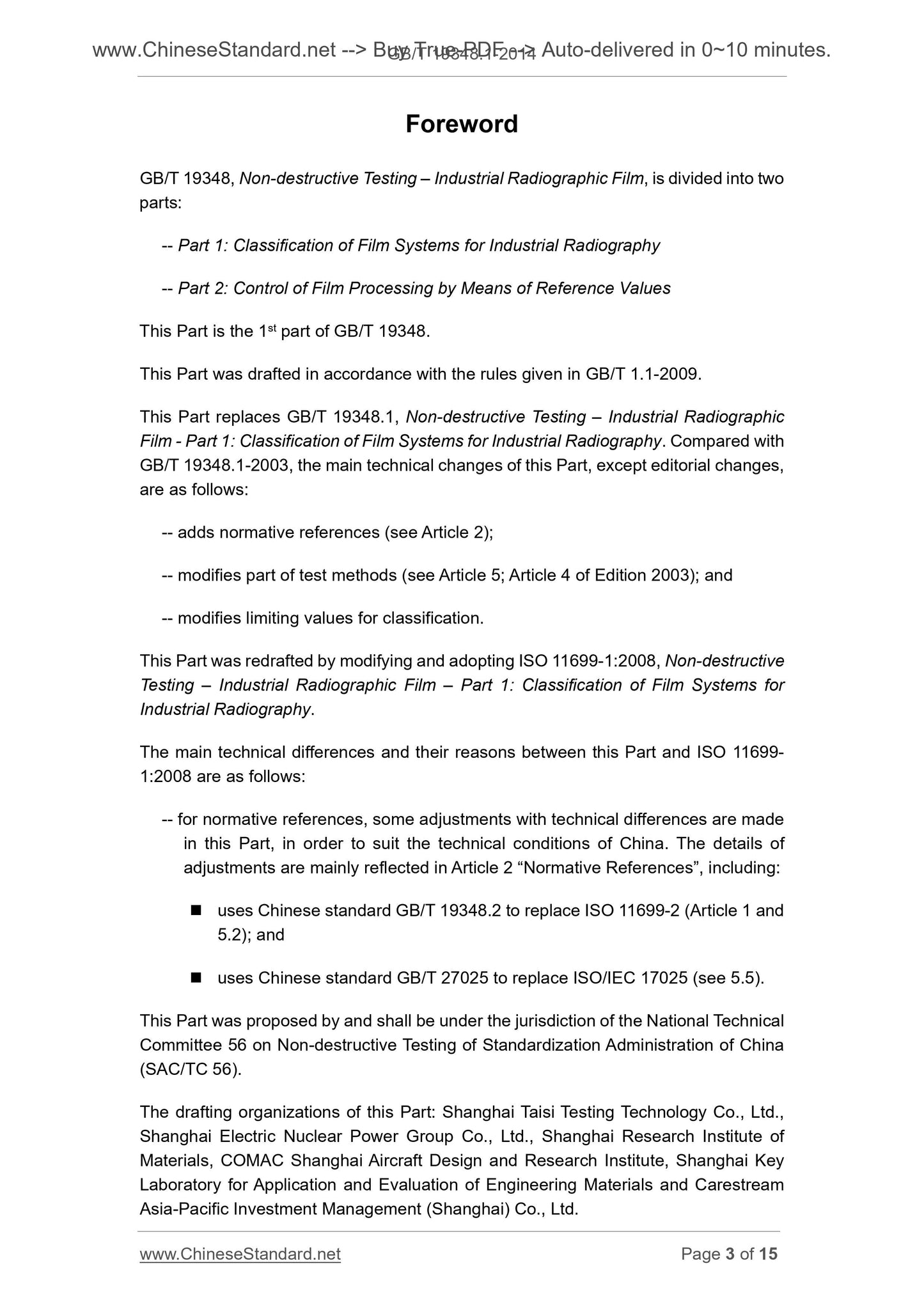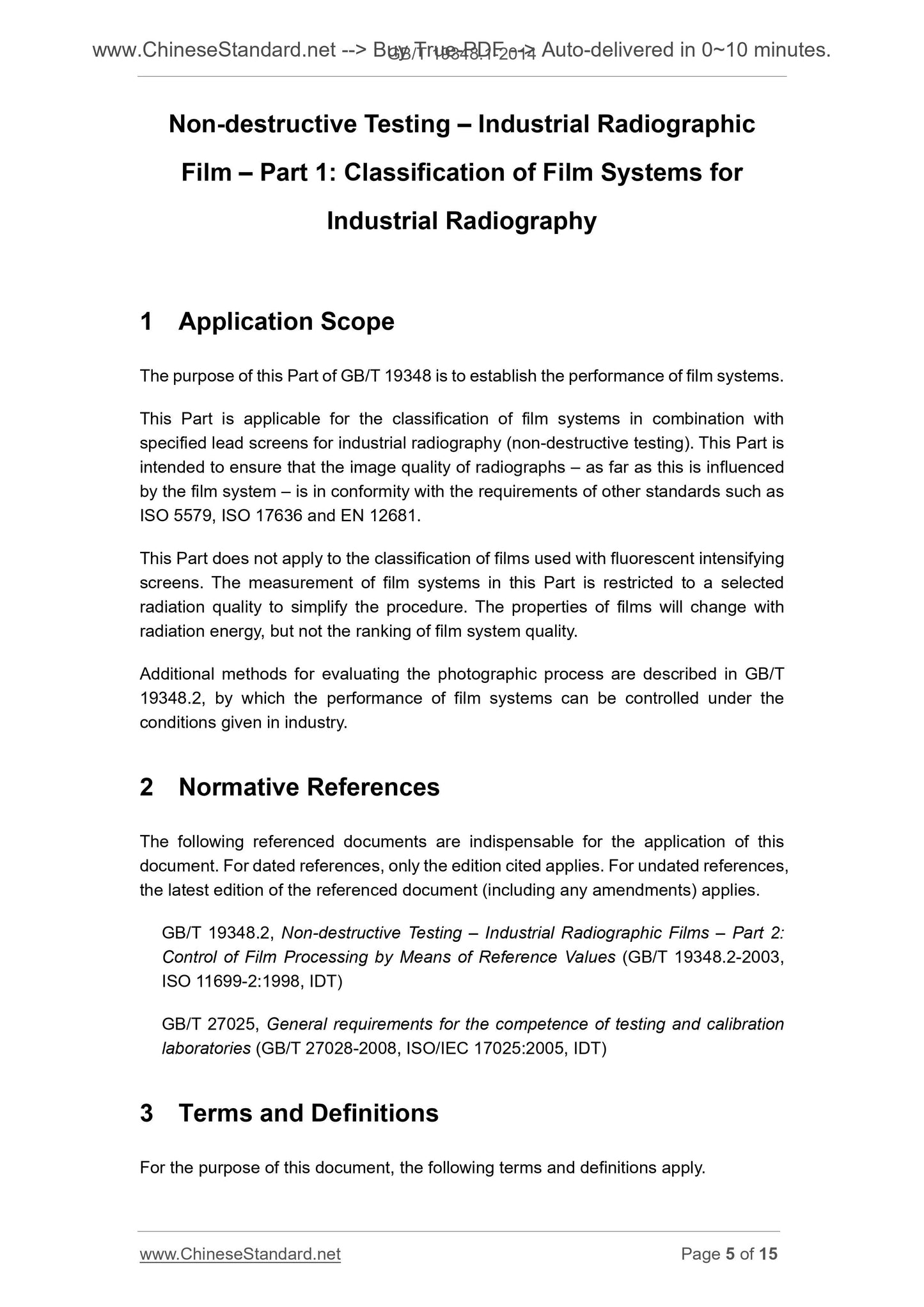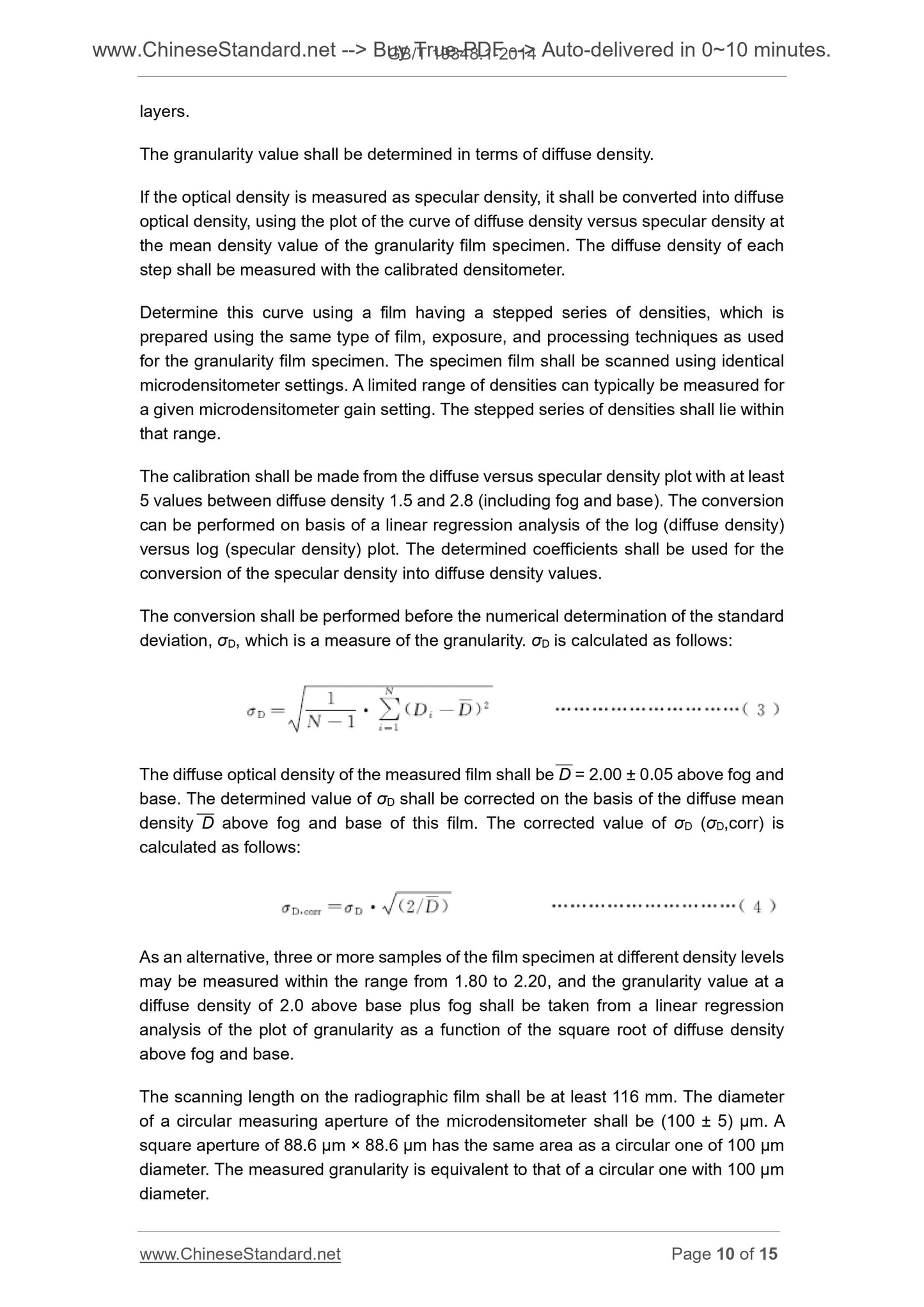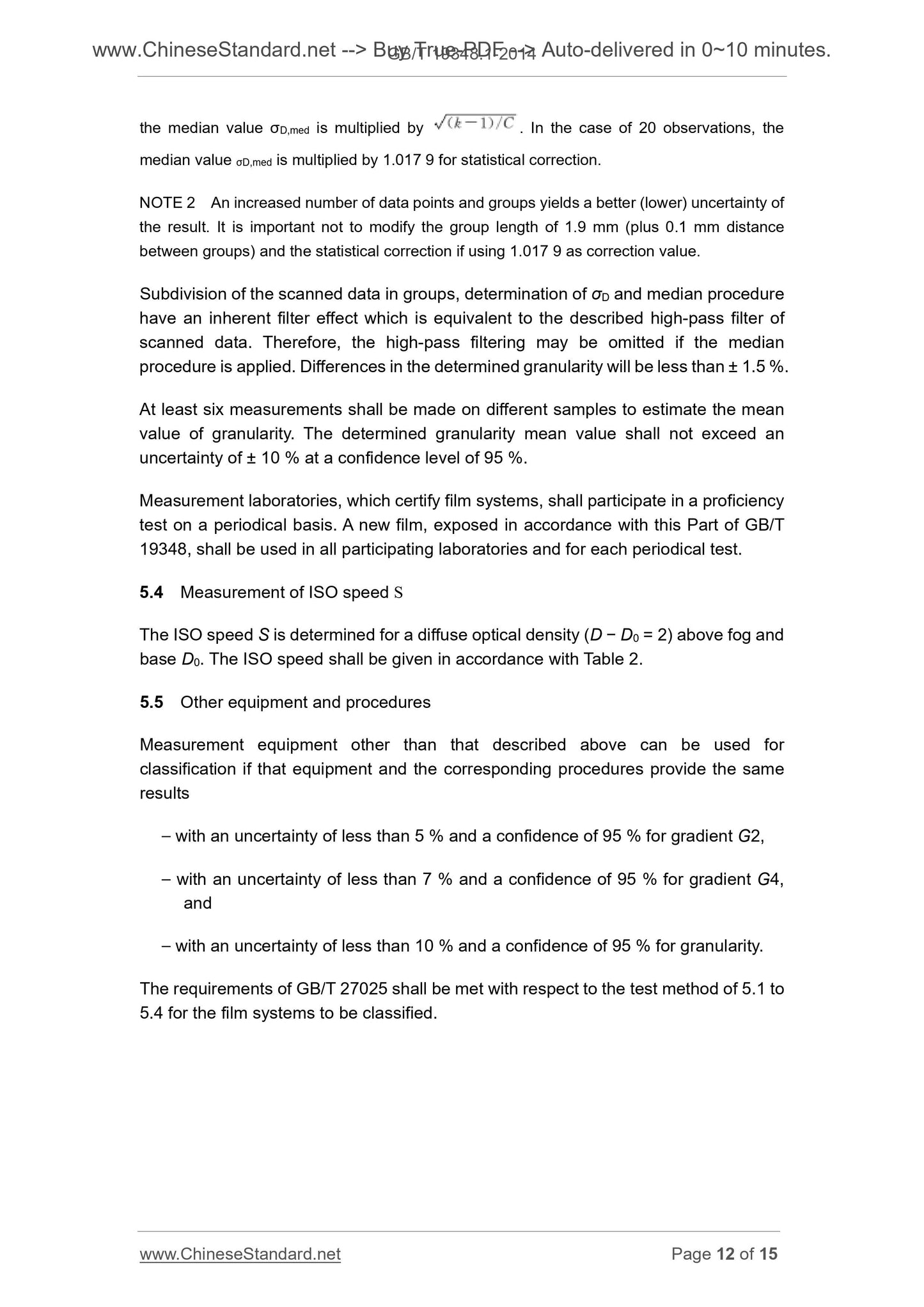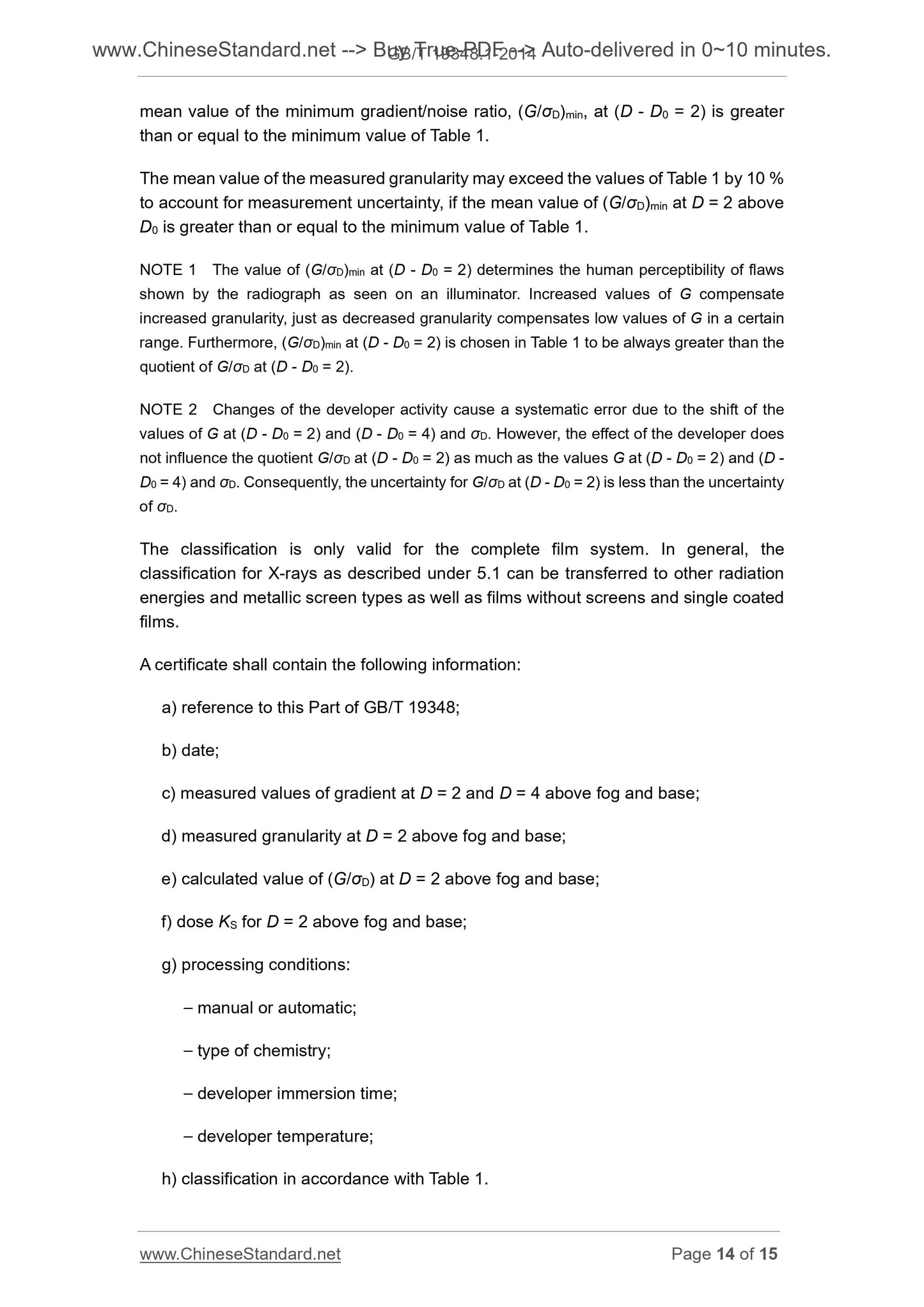1
/
of
7
www.ChineseStandard.us -- Field Test Asia Pte. Ltd.
GB/T 19348.1-2014 English PDF (GB/T19348.1-2014)
GB/T 19348.1-2014 English PDF (GB/T19348.1-2014)
Regular price
$125.00
Regular price
Sale price
$125.00
Unit price
/
per
Shipping calculated at checkout.
Couldn't load pickup availability
GB/T 19348.1-2014: Non-destructive testing -- Industrial radiographic film -- Part 1: Classification of film systems for industrial radiography
Delivery: 9 seconds. Download (& Email) true-PDF + Invoice.
Get Quotation: Click GB/T 19348.1-2014 (Self-service in 1-minute)
Historical versions (Master-website): GB/T 19348.1-2014
Preview True-PDF (Reload/Scroll-down if blank)
GB/T 19348.1-2014
GB
NATIONAL STANDARD OF THE
PEOPLE’S REPUBLIC OF CHINA
ICS 37.040.25; 19.100
J 04
Replacing GB/T 19348.1-2003
Non-destructive Testing – Industrial Radiographic
Film – Part 1. Classification of Film Systems for
Industrial Radiography
(ISO 11699-1. 2008, MOD)
ISSUED ON. JUNE 24, 2014
IMPLEMENTED ON. DECEMBER 31, 2014
Issued by. General Administration of Quality Supervision, Inspection and
Quarantine of the People's Republic of China;
Standardization Administration of the People's Republic of
China.
Table of Contents
Foreword ... 3
1 Application Scope ... 5
2 Normative References ... 5
3 Terms and Definitions ... 5
4 Sampling and Storage ... 7
5 Test Method ... 8
6 Limiting Values for Classification ... 13
Bibliography ... 15
Foreword
GB/T 19348, Non-destructive Testing – Industrial Radiographic Film, is divided into two
parts.
-- Part 1. Classification of Film Systems for Industrial Radiography
-- Part 2. Control of Film Processing by Means of Reference Values
This Part is the 1st part of GB/T 19348.
This Part was drafted in accordance with the rules given in GB/T 1.1-2009.
This Part replaces GB/T 19348.1, Non-destructive Testing – Industrial Radiographic
Film - Part 1. Classification of Film Systems for Industrial Radiography. Compared with
GB/T 19348.1-2003, the main technical changes of this Part, except editorial changes,
are as follows.
-- adds normative references (see Article 2);
-- modifies part of test methods (see Article 5; Article 4 of Edition 2003); and
-- modifies limiting values for classification.
This Part was redrafted by modifying and adopting ISO 11699-1.2008, Non-destructive
Testing – Industrial Radiographic Film – Part 1. Classification of Film Systems for
Industrial Radiography.
The main technical differences and their reasons between this Part and ISO 11699-
1.2008 are as follows.
-- for normative references, some adjustments with technical differences are made
in this Part, in order to suit the technical conditions of China. The details of
adjustments are mainly reflected in Article 2 “Normative References”, including.
uses Chinese standard GB/T 19348.2 to replace ISO 11699-2 (Article 1 and
5.2); and
uses Chinese standard GB/T 27025 to replace ISO/IEC 17025 (see 5.5).
This Part was proposed by and shall be under the jurisdiction of the National Technical
Committee 56 on Non-destructive Testing of Standardization Administration of China
(SAC/TC 56).
The drafting organizations of this Part. Shanghai Taisi Testing Technology Co., Ltd.,
Shanghai Electric Nuclear Power Group Co., Ltd., Shanghai Research Institute of
Materials, COMAC Shanghai Aircraft Design and Research Institute, Shanghai Key
Laboratory for Application and Evaluation of Engineering Materials and Carestream
Asia-Pacific Investment Management (Shanghai) Co., Ltd.
Non-destructive Testing – Industrial Radiographic
Film – Part 1. Classification of Film Systems for
Industrial Radiography
1 Application Scope
The purpose of this Part of GB/T 19348 is to establish the performance of film systems.
This Part is applicable for the classification of film systems in combination with
specified lead screens for industrial radiography (non-destructive testing). This Part is
intended to ensure that the image quality of radiographs – as far as this is influenced
by the film system – is in conformity with the requirements of other standards such as
ISO 5579, ISO 17636 and EN 12681.
This Part does not apply to the classification of films used with fluorescent intensifying
screens. The measurement of film systems in this Part is restricted to a selected
radiation quality to simplify the procedure. The properties of films will change with
radiation energy, but not the ranking of film system quality.
Additional methods for evaluating the photographic process are described in GB/T
19348.2, by which the performance of film systems can be controlled under the
conditions given in industry.
2 Normative References
The following referenced documents are indispensable for the application of this
document. For dated references, only the edition cited applies. For undated references,
the latest edition of the referenced document (including any amendments) applies.
GB/T 19348.2, Non-destructive Testing – Industrial Radiographic Films – Part 2.
Control of Film Processing by Means of Reference Values (GB/T 19348.2-2003,
ISO 11699-2.1998, IDT)
GB/T 27025, General requirements for the competence of testing and calibration
laboratories (GB/T 27028-2008, ISO/IEC 17025.2005, IDT)
3 Terms and Definitions
For the purpose of this document, the following terms and definitions apply.
layers.
The granularity value shall be determined in terms of diffuse density.
If the optical density is measured as specular density, it shall be converted into diffuse
optical density, using the plot of the curve of diffuse density versus specular density at
the mean density value of the granularity film specimen. The diffuse density of each
step shall be measured with the calibrated densitometer.
Determine this curve using a film having a stepped series of densities, which is
prepared using the same type of film, exposure, and processing techniques as used
for the granularity film specimen. The specimen film shall be scanned using identical
microdensitometer settings. A limited range of densities can typically be measured for
a given microdensitometer gain setting. The stepped series of densities shall lie within
that range.
The calibration shall be made from the diffuse versus specular density plot with at least
5 values between diffuse density 1.5 and 2.8 (including fog and base). The conversion
can be performed on basis of a linear regression analysis of the log (diffuse density)
versus log (specular density) plot. The determined coefficients shall be used for the
conversion of the specular density into diffuse density values.
The conversion shall be performed before the numerical determination of the standard
deviation, σD, which is a measure of the granularity. σD is calculated as follows.
The diffuse optical density of the measured film shall be D = 2.00 ± 0.05 above fog and
base. The determined value of σD shall be corrected on the basis of the diffuse mean
density D above fog and base of this film. The corrected value of σD (σD,corr) is
calculated as follows.
As an alternative, three or more samples of the film specimen at different density levels
may be measured within the range from 1.80 to 2.20, and the granularity value at a
diffuse density of 2.0 above base plus fog shall be taken from a linear regression
analysis of the plot of granularity as a function of the square root of diffuse density
above fog and base.
The scanning length on the radiographic film shall be at least 116 mm. The diameter
of a circular measuring aperture of the microdensitometer shall be (100 ± 5) μm. A
square aperture of 88.6 μm × 88.6 μm has the same area as a circular one of 100 μm
diameter. The measured granularity is equivalent to that of a circular one with 100 μm
diameter.
the median value σD,med is multiplied by . In the case of 20 observations, the
median value σD,med is multiplied by 1.017 9 for statistical correction.
NOTE 2 An increased number of data points and groups yields a better (lower) uncertainty of
the result. It is important not to modify the group length of 1.9 mm (plus 0.1 mm distance
between groups) and the statistical correction if using 1.017 9 as correction value.
Subdivision of the scanned data in groups, determination of σD and median procedure
have an inherent filter effect which is equivalent to the described high-pass filter of
scanned data. Therefore, the high-pass filtering may be omitted if the median
procedure is applied. Differences in the determined granularity will be less than ± 1.5 %.
At least six measurements shall be made on different samples to estimate the mean
value of granularity. The determined granularity mean value shall not exceed an
uncertainty of ± 10 % at a confidence level of 95 %.
Measurement laboratories, which certify film systems, shall participate in a proficiency
test on a periodical basis. A new film, exposed in accordance with this Part of GB/T
19348, shall be used in all participating laboratories and for each periodical test.
5.4 Measurement of ISO speed S
The ISO speed S is determined for a diffuse optical density (D − D0 = 2) above fog and
base D0. The ISO speed shall be given in accordance with Table 2.
5.5 Other equipment and procedures
Measurement equipment other than that described above can be used for
classification if that equipment and the corresponding procedures provide the same
results
ۛ with an uncertainty of less than 5 % and a confidence of 95 % for gradient G2,
ۛ with an uncertainty of less than 7 % and a confidence of 95 % for gradient G4,
and
ۛ with an uncertainty of less than 10 % and a confidence of 95 % for granularity.
The requirements of GB/T 27025 shall be met with respect to the test method of 5.1 t...
GB/T 19348.1-2014
GB
NATIONAL STANDARD OF THE
PEOPLE’S REPUBLIC OF CHINA
ICS 37.040.25; 19.100
J 04
Replacing GB/T 19348.1-2003
Non-destructive Testing – Industrial Radiographic
Film – Part 1. Classification of Film Systems for
Industrial Radiography
(ISO 11699-1. 2008, MOD)
ISSUED ON. JUNE 24, 2014
IMPLEMENTED ON. DECEMBER 31, 2014
Issued by. General Administration of Quality Supervision, Inspection and
Quarantine of the People's Republic of China;
Standardization Administration of the People's Republic of
China.
Table of Contents
Foreword ... 3
1 Application Scope ... 5
2 Normative References ... 5
3 Terms and Definitions ... 5
4 Sampling and Storage ... 7
5 Test Method ... 8
6 Limiting Values for Classification ... 13
Bibliography ... 15
Foreword
GB/T 19348, Non-destructive Testing – Industrial Radiographic Film, is divided into two
parts.
-- Part 1. Classification of Film Systems for Industrial Radiography
-- Part 2. Control of Film Processing by Means of Reference Values
This Part is the 1st part of GB/T 19348.
This Part was drafted in accordance with the rules given in GB/T 1.1-2009.
This Part replaces GB/T 19348.1, Non-destructive Testing – Industrial Radiographic
Film - Part 1. Classification of Film Systems for Industrial Radiography. Compared with
GB/T 19348.1-2003, the main technical changes of this Part, except editorial changes,
are as follows.
-- adds normative references (see Article 2);
-- modifies part of test methods (see Article 5; Article 4 of Edition 2003); and
-- modifies limiting values for classification.
This Part was redrafted by modifying and adopting ISO 11699-1.2008, Non-destructive
Testing – Industrial Radiographic Film – Part 1. Classification of Film Systems for
Industrial Radiography.
The main technical differences and their reasons between this Part and ISO 11699-
1.2008 are as follows.
-- for normative references, some adjustments with technical differences are made
in this Part, in order to suit the technical conditions of China. The details of
adjustments are mainly reflected in Article 2 “Normative References”, including.
uses Chinese standard GB/T 19348.2 to replace ISO 11699-2 (Article 1 and
5.2); and
uses Chinese standard GB/T 27025 to replace ISO/IEC 17025 (see 5.5).
This Part was proposed by and shall be under the jurisdiction of the National Technical
Committee 56 on Non-destructive Testing of Standardization Administration of China
(SAC/TC 56).
The drafting organizations of this Part. Shanghai Taisi Testing Technology Co., Ltd.,
Shanghai Electric Nuclear Power Group Co., Ltd., Shanghai Research Institute of
Materials, COMAC Shanghai Aircraft Design and Research Institute, Shanghai Key
Laboratory for Application and Evaluation of Engineering Materials and Carestream
Asia-Pacific Investment Management (Shanghai) Co., Ltd.
Non-destructive Testing – Industrial Radiographic
Film – Part 1. Classification of Film Systems for
Industrial Radiography
1 Application Scope
The purpose of this Part of GB/T 19348 is to establish the performance of film systems.
This Part is applicable for the classification of film systems in combination with
specified lead screens for industrial radiography (non-destructive testing). This Part is
intended to ensure that the image quality of radiographs – as far as this is influenced
by the film system – is in conformity with the requirements of other standards such as
ISO 5579, ISO 17636 and EN 12681.
This Part does not apply to the classification of films used with fluorescent intensifying
screens. The measurement of film systems in this Part is restricted to a selected
radiation quality to simplify the procedure. The properties of films will change with
radiation energy, but not the ranking of film system quality.
Additional methods for evaluating the photographic process are described in GB/T
19348.2, by which the performance of film systems can be controlled under the
conditions given in industry.
2 Normative References
The following referenced documents are indispensable for the application of this
document. For dated references, only the edition cited applies. For undated references,
the latest edition of the referenced document (including any amendments) applies.
GB/T 19348.2, Non-destructive Testing – Industrial Radiographic Films – Part 2.
Control of Film Processing by Means of Reference Values (GB/T 19348.2-2003,
ISO 11699-2.1998, IDT)
GB/T 27025, General requirements for the competence of testing and calibration
laboratories (GB/T 27028-2008, ISO/IEC 17025.2005, IDT)
3 Terms and Definitions
For the purpose of this document, the following terms and definitions apply.
layers.
The granularity value shall be determined in terms of diffuse density.
If the optical density is measured as specular density, it shall be converted into diffuse
optica...
Delivery: 9 seconds. Download (& Email) true-PDF + Invoice.
Get Quotation: Click GB/T 19348.1-2014 (Self-service in 1-minute)
Historical versions (Master-website): GB/T 19348.1-2014
Preview True-PDF (Reload/Scroll-down if blank)
GB/T 19348.1-2014
GB
NATIONAL STANDARD OF THE
PEOPLE’S REPUBLIC OF CHINA
ICS 37.040.25; 19.100
J 04
Replacing GB/T 19348.1-2003
Non-destructive Testing – Industrial Radiographic
Film – Part 1. Classification of Film Systems for
Industrial Radiography
(ISO 11699-1. 2008, MOD)
ISSUED ON. JUNE 24, 2014
IMPLEMENTED ON. DECEMBER 31, 2014
Issued by. General Administration of Quality Supervision, Inspection and
Quarantine of the People's Republic of China;
Standardization Administration of the People's Republic of
China.
Table of Contents
Foreword ... 3
1 Application Scope ... 5
2 Normative References ... 5
3 Terms and Definitions ... 5
4 Sampling and Storage ... 7
5 Test Method ... 8
6 Limiting Values for Classification ... 13
Bibliography ... 15
Foreword
GB/T 19348, Non-destructive Testing – Industrial Radiographic Film, is divided into two
parts.
-- Part 1. Classification of Film Systems for Industrial Radiography
-- Part 2. Control of Film Processing by Means of Reference Values
This Part is the 1st part of GB/T 19348.
This Part was drafted in accordance with the rules given in GB/T 1.1-2009.
This Part replaces GB/T 19348.1, Non-destructive Testing – Industrial Radiographic
Film - Part 1. Classification of Film Systems for Industrial Radiography. Compared with
GB/T 19348.1-2003, the main technical changes of this Part, except editorial changes,
are as follows.
-- adds normative references (see Article 2);
-- modifies part of test methods (see Article 5; Article 4 of Edition 2003); and
-- modifies limiting values for classification.
This Part was redrafted by modifying and adopting ISO 11699-1.2008, Non-destructive
Testing – Industrial Radiographic Film – Part 1. Classification of Film Systems for
Industrial Radiography.
The main technical differences and their reasons between this Part and ISO 11699-
1.2008 are as follows.
-- for normative references, some adjustments with technical differences are made
in this Part, in order to suit the technical conditions of China. The details of
adjustments are mainly reflected in Article 2 “Normative References”, including.
uses Chinese standard GB/T 19348.2 to replace ISO 11699-2 (Article 1 and
5.2); and
uses Chinese standard GB/T 27025 to replace ISO/IEC 17025 (see 5.5).
This Part was proposed by and shall be under the jurisdiction of the National Technical
Committee 56 on Non-destructive Testing of Standardization Administration of China
(SAC/TC 56).
The drafting organizations of this Part. Shanghai Taisi Testing Technology Co., Ltd.,
Shanghai Electric Nuclear Power Group Co., Ltd., Shanghai Research Institute of
Materials, COMAC Shanghai Aircraft Design and Research Institute, Shanghai Key
Laboratory for Application and Evaluation of Engineering Materials and Carestream
Asia-Pacific Investment Management (Shanghai) Co., Ltd.
Non-destructive Testing – Industrial Radiographic
Film – Part 1. Classification of Film Systems for
Industrial Radiography
1 Application Scope
The purpose of this Part of GB/T 19348 is to establish the performance of film systems.
This Part is applicable for the classification of film systems in combination with
specified lead screens for industrial radiography (non-destructive testing). This Part is
intended to ensure that the image quality of radiographs – as far as this is influenced
by the film system – is in conformity with the requirements of other standards such as
ISO 5579, ISO 17636 and EN 12681.
This Part does not apply to the classification of films used with fluorescent intensifying
screens. The measurement of film systems in this Part is restricted to a selected
radiation quality to simplify the procedure. The properties of films will change with
radiation energy, but not the ranking of film system quality.
Additional methods for evaluating the photographic process are described in GB/T
19348.2, by which the performance of film systems can be controlled under the
conditions given in industry.
2 Normative References
The following referenced documents are indispensable for the application of this
document. For dated references, only the edition cited applies. For undated references,
the latest edition of the referenced document (including any amendments) applies.
GB/T 19348.2, Non-destructive Testing – Industrial Radiographic Films – Part 2.
Control of Film Processing by Means of Reference Values (GB/T 19348.2-2003,
ISO 11699-2.1998, IDT)
GB/T 27025, General requirements for the competence of testing and calibration
laboratories (GB/T 27028-2008, ISO/IEC 17025.2005, IDT)
3 Terms and Definitions
For the purpose of this document, the following terms and definitions apply.
layers.
The granularity value shall be determined in terms of diffuse density.
If the optical density is measured as specular density, it shall be converted into diffuse
optical density, using the plot of the curve of diffuse density versus specular density at
the mean density value of the granularity film specimen. The diffuse density of each
step shall be measured with the calibrated densitometer.
Determine this curve using a film having a stepped series of densities, which is
prepared using the same type of film, exposure, and processing techniques as used
for the granularity film specimen. The specimen film shall be scanned using identical
microdensitometer settings. A limited range of densities can typically be measured for
a given microdensitometer gain setting. The stepped series of densities shall lie within
that range.
The calibration shall be made from the diffuse versus specular density plot with at least
5 values between diffuse density 1.5 and 2.8 (including fog and base). The conversion
can be performed on basis of a linear regression analysis of the log (diffuse density)
versus log (specular density) plot. The determined coefficients shall be used for the
conversion of the specular density into diffuse density values.
The conversion shall be performed before the numerical determination of the standard
deviation, σD, which is a measure of the granularity. σD is calculated as follows.
The diffuse optical density of the measured film shall be D = 2.00 ± 0.05 above fog and
base. The determined value of σD shall be corrected on the basis of the diffuse mean
density D above fog and base of this film. The corrected value of σD (σD,corr) is
calculated as follows.
As an alternative, three or more samples of the film specimen at different density levels
may be measured within the range from 1.80 to 2.20, and the granularity value at a
diffuse density of 2.0 above base plus fog shall be taken from a linear regression
analysis of the plot of granularity as a function of the square root of diffuse density
above fog and base.
The scanning length on the radiographic film shall be at least 116 mm. The diameter
of a circular measuring aperture of the microdensitometer shall be (100 ± 5) μm. A
square aperture of 88.6 μm × 88.6 μm has the same area as a circular one of 100 μm
diameter. The measured granularity is equivalent to that of a circular one with 100 μm
diameter.
the median value σD,med is multiplied by . In the case of 20 observations, the
median value σD,med is multiplied by 1.017 9 for statistical correction.
NOTE 2 An increased number of data points and groups yields a better (lower) uncertainty of
the result. It is important not to modify the group length of 1.9 mm (plus 0.1 mm distance
between groups) and the statistical correction if using 1.017 9 as correction value.
Subdivision of the scanned data in groups, determination of σD and median procedure
have an inherent filter effect which is equivalent to the described high-pass filter of
scanned data. Therefore, the high-pass filtering may be omitted if the median
procedure is applied. Differences in the determined granularity will be less than ± 1.5 %.
At least six measurements shall be made on different samples to estimate the mean
value of granularity. The determined granularity mean value shall not exceed an
uncertainty of ± 10 % at a confidence level of 95 %.
Measurement laboratories, which certify film systems, shall participate in a proficiency
test on a periodical basis. A new film, exposed in accordance with this Part of GB/T
19348, shall be used in all participating laboratories and for each periodical test.
5.4 Measurement of ISO speed S
The ISO speed S is determined for a diffuse optical density (D − D0 = 2) above fog and
base D0. The ISO speed shall be given in accordance with Table 2.
5.5 Other equipment and procedures
Measurement equipment other than that described above can be used for
classification if that equipment and the corresponding procedures provide the same
results
ۛ with an uncertainty of less than 5 % and a confidence of 95 % for gradient G2,
ۛ with an uncertainty of less than 7 % and a confidence of 95 % for gradient G4,
and
ۛ with an uncertainty of less than 10 % and a confidence of 95 % for granularity.
The requirements of GB/T 27025 shall be met with respect to the test method of 5.1 t...
GB/T 19348.1-2014
GB
NATIONAL STANDARD OF THE
PEOPLE’S REPUBLIC OF CHINA
ICS 37.040.25; 19.100
J 04
Replacing GB/T 19348.1-2003
Non-destructive Testing – Industrial Radiographic
Film – Part 1. Classification of Film Systems for
Industrial Radiography
(ISO 11699-1. 2008, MOD)
ISSUED ON. JUNE 24, 2014
IMPLEMENTED ON. DECEMBER 31, 2014
Issued by. General Administration of Quality Supervision, Inspection and
Quarantine of the People's Republic of China;
Standardization Administration of the People's Republic of
China.
Table of Contents
Foreword ... 3
1 Application Scope ... 5
2 Normative References ... 5
3 Terms and Definitions ... 5
4 Sampling and Storage ... 7
5 Test Method ... 8
6 Limiting Values for Classification ... 13
Bibliography ... 15
Foreword
GB/T 19348, Non-destructive Testing – Industrial Radiographic Film, is divided into two
parts.
-- Part 1. Classification of Film Systems for Industrial Radiography
-- Part 2. Control of Film Processing by Means of Reference Values
This Part is the 1st part of GB/T 19348.
This Part was drafted in accordance with the rules given in GB/T 1.1-2009.
This Part replaces GB/T 19348.1, Non-destructive Testing – Industrial Radiographic
Film - Part 1. Classification of Film Systems for Industrial Radiography. Compared with
GB/T 19348.1-2003, the main technical changes of this Part, except editorial changes,
are as follows.
-- adds normative references (see Article 2);
-- modifies part of test methods (see Article 5; Article 4 of Edition 2003); and
-- modifies limiting values for classification.
This Part was redrafted by modifying and adopting ISO 11699-1.2008, Non-destructive
Testing – Industrial Radiographic Film – Part 1. Classification of Film Systems for
Industrial Radiography.
The main technical differences and their reasons between this Part and ISO 11699-
1.2008 are as follows.
-- for normative references, some adjustments with technical differences are made
in this Part, in order to suit the technical conditions of China. The details of
adjustments are mainly reflected in Article 2 “Normative References”, including.
uses Chinese standard GB/T 19348.2 to replace ISO 11699-2 (Article 1 and
5.2); and
uses Chinese standard GB/T 27025 to replace ISO/IEC 17025 (see 5.5).
This Part was proposed by and shall be under the jurisdiction of the National Technical
Committee 56 on Non-destructive Testing of Standardization Administration of China
(SAC/TC 56).
The drafting organizations of this Part. Shanghai Taisi Testing Technology Co., Ltd.,
Shanghai Electric Nuclear Power Group Co., Ltd., Shanghai Research Institute of
Materials, COMAC Shanghai Aircraft Design and Research Institute, Shanghai Key
Laboratory for Application and Evaluation of Engineering Materials and Carestream
Asia-Pacific Investment Management (Shanghai) Co., Ltd.
Non-destructive Testing – Industrial Radiographic
Film – Part 1. Classification of Film Systems for
Industrial Radiography
1 Application Scope
The purpose of this Part of GB/T 19348 is to establish the performance of film systems.
This Part is applicable for the classification of film systems in combination with
specified lead screens for industrial radiography (non-destructive testing). This Part is
intended to ensure that the image quality of radiographs – as far as this is influenced
by the film system – is in conformity with the requirements of other standards such as
ISO 5579, ISO 17636 and EN 12681.
This Part does not apply to the classification of films used with fluorescent intensifying
screens. The measurement of film systems in this Part is restricted to a selected
radiation quality to simplify the procedure. The properties of films will change with
radiation energy, but not the ranking of film system quality.
Additional methods for evaluating the photographic process are described in GB/T
19348.2, by which the performance of film systems can be controlled under the
conditions given in industry.
2 Normative References
The following referenced documents are indispensable for the application of this
document. For dated references, only the edition cited applies. For undated references,
the latest edition of the referenced document (including any amendments) applies.
GB/T 19348.2, Non-destructive Testing – Industrial Radiographic Films – Part 2.
Control of Film Processing by Means of Reference Values (GB/T 19348.2-2003,
ISO 11699-2.1998, IDT)
GB/T 27025, General requirements for the competence of testing and calibration
laboratories (GB/T 27028-2008, ISO/IEC 17025.2005, IDT)
3 Terms and Definitions
For the purpose of this document, the following terms and definitions apply.
layers.
The granularity value shall be determined in terms of diffuse density.
If the optical density is measured as specular density, it shall be converted into diffuse
optica...
Share
